Contents
Swimming freestyle is a great low impact exercise that does wonders for strengthening the cardiovascular system. Swimming freestyle strengthens the upper and lower body as well as the core. However, swimming freestyle can be difficult. In fact, for someone who has never swum freestyle before, it can be fairly daunting. Heck, just keeping your face down in the water is enough to freak some people out – it was for me. 🙂
When I started swimming freestyle, I had a tough time swimming over 25 yards. It took quite a while before I could make 50 yards without needing to rest or catch my breath. With time and patience, I learned techniques that helped me to increase my distance. Below are my 5 tips on how to swim freestyle without getting tired.
When learning how to swim freestyle without getting tired, the very first thing you need to learn is how to breathe properly. Your muscles need tons of oxygen when swimming and exerting themselves. The basics of breathing while swimming freestyle are:
When swimming freestyle, you need to learn to keep your face down in the water. I know, it can be freaky if you aren’t used to it. But just take it slow – it gets easier the more you do it. You have to get this part right to keep your hips and legs from dragging down in the water. If that happens, it will be virtually impossible to swim freestyle without getting tired. It will be like trying to swim with bricks tied to you!
This is kind of embarrassing to admit… This is something I didn’t understand when I started swimming freestyle. I thought I had to exhale and quickly inhale when I brought my head to the side. I just couldn’t get enough oxygen in that short amount of time. Actually, this is the number one mistake of new freestyle swimmers.Exhale under water in between breaths.
I thought I had to exhale and quickly inhale when I brought my head to the side. I just couldn’t get enough oxygen in that short amount of time. Actually, this is the number one mistake of new freestyle swimmers.Exhale under water in between breaths.
The correct way is to exhale fully through your nose while your face is underwater. Then when you turn your head, inhale through the mouth. Once I realized that and got used to it, the breathing process became so much easier! Also, my body and muscles were getting more oxygen, which they liked.
Speedo Vanquisher 2.0 Goggles
With Speedo Black Swim Camp
There is much debate on whether breathing to one side or both sides is better for swimming freestyle. The argument is that since competitive swimmers breathe on one side, shouldn’t we be doing the same? I don’t know about you, but I haven’t qualified for the olympics lately… Even competitive swimmers regularly train by breathing bilaterally.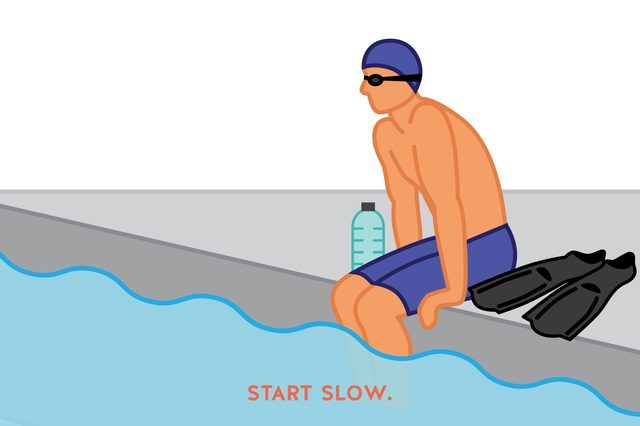
Since you want to learn how to swim freestyle without getting tired (and not qualify for the olympics), I would learn to breathe bilaterally. As mentioned above your muscles need lots of oxygen when swimming freestyle. Breathing on both sides will give your body the chance to get that much needed oxygen. In addition, by breathing bilaterally, you will have a more balanced and symmetrical stroke.
An important point when learning how to swim freestyle without getting tired is to not shorten your stroke. What that means is to take nice long extended strokes – not wimpy short ones. When taking a stroke, envision reaching far ahead in the water and then pulling your body through the water with your hands.
The first step is to check your position in the water. Your body should be flat and horizontal throughout the freestyle stroke as this helps to decrease drag.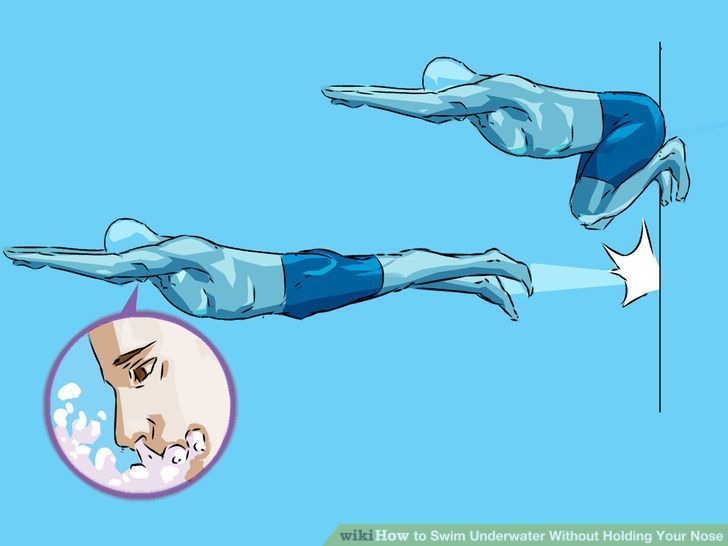
Now, reach as far forward as possible with your hand as it enters the water. As your hand enters the water, pull back with as much force as you can while reaching as far forward with your other arm. You should feel a good stretch in your lats with each stroke. Long arm strokes will help to give you maximum thrust in the water with less energy consumption.
Speedo Swim KickboardAmazon Bestseller
With any endurance activity, you can’t expect to train once or twice a week and become proficient in it. The same holds true with swimming freestyle. An important part of learning how to swim freestyle without getting tired is to increase your training frequency.
While I can’t tell you how often you should train, I can say you will probably not see any gains with swimming once or twice a week. By increasing your training to at least 3-4 times a week, your body will become more used to being in the water.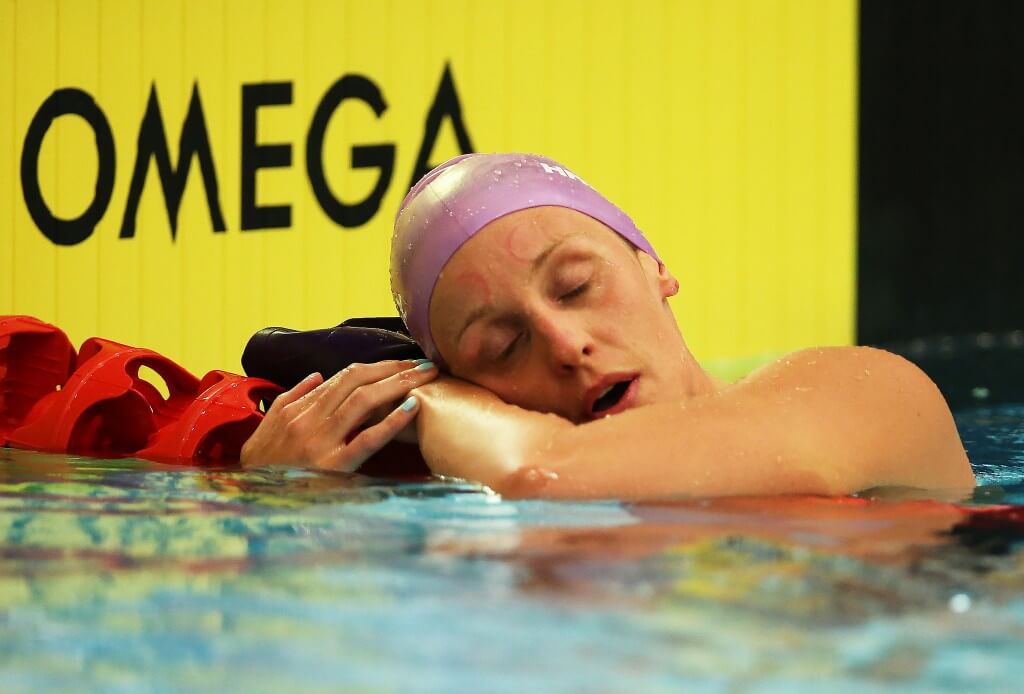 Your entire cardiovascular system will become stronger. Your breathing will become easier. Your muscles will become stronger and your strokes will seem easier. Swimming will feel natural and you will relax the more time you spend in the water.
Your entire cardiovascular system will become stronger. Your breathing will become easier. Your muscles will become stronger and your strokes will seem easier. Swimming will feel natural and you will relax the more time you spend in the water.
Knowing how to swim freestyle without getting tired relies so much on the strength of your cardiovascular system. The days you don’t swim, do a form of cross training. That could involve running or biking. By cross training, you will get additional cardiovascular benefits that will help you in the pool. Also, it will be a pleasant change from your swimming training.
Proper nutrition is vital when learning how to swim freestyle without getting tired. You need to fuel your body before and during swim workouts. Be sure to eat plenty of lean protein, vegetables, fruits and whole grain foods throughout the day. Swimming freestyle eats up calories like the cookie monster!
Just as important as eating is making sure you are consuming enough fluids. Be sure to drink plenty of water throughout each day to stay hydrated. While you might not realize it, your body sweats lots of fluid while swimming. You need to make sure you replenish lost fluids.
Be sure to drink plenty of water throughout each day to stay hydrated. While you might not realize it, your body sweats lots of fluid while swimming. You need to make sure you replenish lost fluids.
FINIS Training
Swim Fins
During long swimming sessions, make it a habit to bring a water bottle and a couple snack bars with you for brief breaks. This will help to keep you hydrated and keep your energy level up during your training. Just this will go a long way in helping to keep you from getting tired!
Swimming freestyle can be tough, especially for beginner swimmers. But, knowing how to swim freestyle without getting tired isn’t too difficult if you follow the above five tips. They are key to being able to swim freestyle longer without getting tired. Remember that it will take time and to be patient. Every workout you spend in the water, you are getting closer to your goal!
Categories Swimming
Previous
Next
Every type of swimming challenge and goal you want to achieve has its own most common mistakes and techniques to achieve them. Very often this overarching goal is speed for those who compete. But there’s a lot of swimmers who focus on long-distance training and this requires slightly different technique.
Very often this overarching goal is speed for those who compete. But there’s a lot of swimmers who focus on long-distance training and this requires slightly different technique.
That’s why today we’re going to look at this kind of training and give you four simple tips to swim long distance efficiently and without getting tired.
Long strokes are a crucial element of the efficient long distance swim. To achieve this while using front crawl you have to start with proper body position – flat and horizontal – this is necessary at all times and your movement shouldn’t compromise it as it minimizes the drag and using your every movement more efficiently.
Now that your body is properly positioned you can think about your arms pull – you need to reach as far forward as possible. When you’re pulling back – use maximum force while stretching opposite arm as far forward as possible and so on. These two things (stretching arms while your body stays flat and horizontal) are the basic mechanism that will propel you in the most efficient way.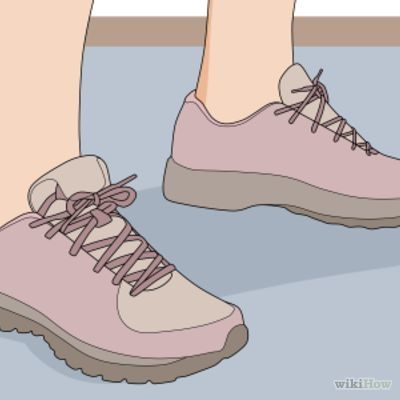 and that means more power preserved for your long distance swim. Short arm pulls give you less propulsion with higher energy consumption so don’t do it!
and that means more power preserved for your long distance swim. Short arm pulls give you less propulsion with higher energy consumption so don’t do it!
Your muscles need oxygen. Your muscles while swimming need A LOT of oxygen. This is pure biology and you have to accept it and adapt to it if you want to see any success in long-distance swimming.
There are three basic rules that combined will help you breathe while swimming in a way that gives your body oxygen while it is not producing drag or distraction.
1. Keep your face in the water. We know it might be uncomfortable at the beginning but it is a must as you swimming with your head up your hips and legs will go deeper underwater and you will lose the body position we talked in the previous section.
2. Exhale under water. This is the most common mistake among beginner swimmers – they exhale and inhale quickly when they turn to breathe. This gives you little oxygen and holding your breath underwater doesn’t help you either. The proper way is to breathe in while turning and breath out with your head already in the water using your nose and mouth. That is another thing might seem uncomfortable and at the beginning, it will be, but that’s the way of getting as much oxygen while minimizing the time your face is out of the water and your head is up.
The proper way is to breathe in while turning and breath out with your head already in the water using your nose and mouth. That is another thing might seem uncomfortable and at the beginning, it will be, but that’s the way of getting as much oxygen while minimizing the time your face is out of the water and your head is up.
3. One-sided breathing. For long distance and any hard swimming session, the way to go is one-sided breathing pattern that gives you good rhythm and good flow of the oxygen. The thing to watch out for is a slight body imbalance you need to correct when breathing on one side only.
The sum of all these rules implemented means more oxygen and better rhythm while swimming and that means more power and efficiency in the water.
Swimming is very taxing for our bodies as far as calories burned and need for fluids. You can read our articles on nutrition and water consumption for swimmers. The general rules are to eat whole grains, vegetables and plenty of lean protein while drinking A LOT of fluids during your training sessions and competitions. To produce the energy you need for long distance swimming you need to provide it to your body first!
To produce the energy you need for long distance swimming you need to provide it to your body first!
Always remember to have a big bottle of water and few energy bars with you to snack between the sets. It’s really incredible how much calories we burn and how much we sweat during an intense swimming session!
Long distance swimming is a constant process and as in cycling and running you need to set your workout goals in a particular way so you can progress gradually. Attacking full 10k at the beginning can only end up with an injury or you losing all your motivation. That’s why you should build your sets by starting with 50 meters at a certain pace for 10 intervals and then move to 75 meters and 100 etc. This will build your fitness and endurance while you also improve your stroke technique and efficiency in the pool. That is the safe and much more satisfying way to get there as you will constantly see progress and will be able to finish your sets without having a nervous and physical breakdown! :)
In our years of conversations with long-distance swimmers, the simple things like lap counting and keeping a steady pace (not starting too fast) is just as important as post-training analysis and constant control over the progress they’ve made already.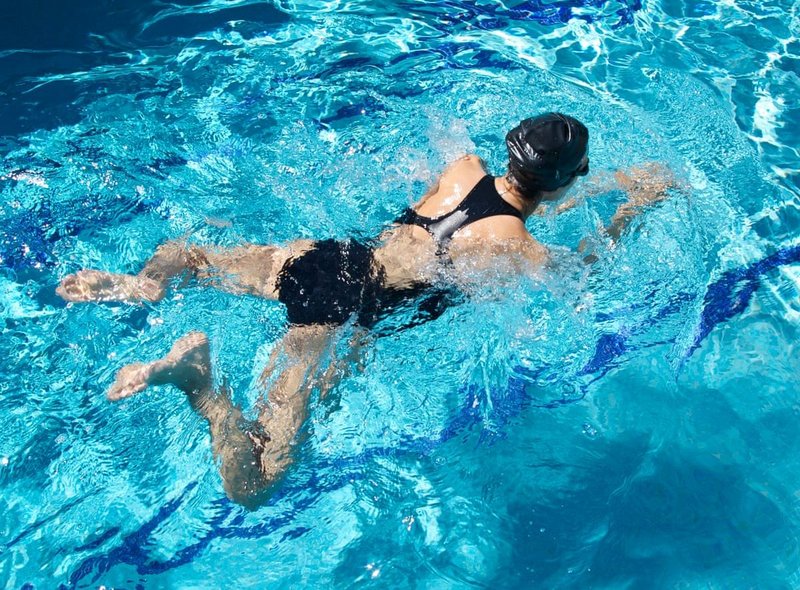 Swimmo training watch for swimmers can help with all of those things and much much more resulting in healthier and more effective training sessions that will result in you being able to do longer distances and better pace without getting completely exhausted.
Swimmo training watch for swimmers can help with all of those things and much much more resulting in healthier and more effective training sessions that will result in you being able to do longer distances and better pace without getting completely exhausted.
Kamil Market Development Expert at Swimmo
Among the huge number of tips and life hacks on the Internet, how to swim without getting tired, a simple swimmer can get confused and start grabbing all the tips at once.
First of all, you need to remember 5 main things!!...
Attention!
First! If you want to swim for a long time without getting tired, swim in the first 15-20 days - not enough!!
Second! Practice in the pool in a wetsuit!!
Third! We put equipment - only in shallow water!
Fourth! Setting up the technique of working arms and legs in swims - only while holding your breath!
Fifth! The beginning of breathing practice - only setting the correct work of the arms and legs!
And at the first stage of training, before working out the movements of the arms and legs, the work of the arms and legs, one must learn to slide in the water, leaning on it not only with the chest, but also with the face, like on a water pillow.
If you learn to do this, swimming will immediately become much easier, because you will have not 1, but 2 points of support: chest and face, and your body will take the most optimal position in the water for swimming.
Exercise number 1 . It is necessary in the water, the level of which is not higher than your chest - I emphasize - not higher than your chest, gently lie down on the water, and completely relax! Just hang in the water while holding your breath. Become soft like a jellyfish. Leaning face on the water! This is not only a very pleasant, but a very important exercise!
By the way, not everyone can do it right away. See what typical mistakes swimmers make: they jump into the water, and their arms and legs are tense, and they can’t completely relax. Meanwhile, it's really simple. If you don't hurry
Inhale gently and first touch the water with your chin, and only then gently place your face and whole body on the water. Freeze completely relaxed. Make sure that not only the neck, face, but the whole head is relaxed ..... arms, shoulders, and most importantly - your knees and feet !! Yes Yes! Do not rest your feet on the bottom, even if they touch it. Hang in the water like a soft jellyfish! And after 10-15-20 seconds, gently stand up! Then repeat this exercise several times!
Make sure that not only the neck, face, but the whole head is relaxed ..... arms, shoulders, and most importantly - your knees and feet !! Yes Yes! Do not rest your feet on the bottom, even if they touch it. Hang in the water like a soft jellyfish! And after 10-15-20 seconds, gently stand up! Then repeat this exercise several times!
If you can completely relax, congratulations, you can move on!
Exercise 2: Arrow! Gliding in the water, with outstretched arms and legs!
And before you practice this slide, answer one question:
What is the best way to practice this exercise when the hands are on top of each other, or when they are parallel to each other, like skis on a track?
Of course, if you're jumping off the bench in a competition and swimming underwater, then your hands should be together, one above the other, so as not to create unnecessary resistance in the water!
NO!
We are now preparing for a comfortable and correct front crawl swimming. And in this case, it is better to immediately learn the arrow with arms spread shoulder-width apart. Why?
And in this case, it is better to immediately learn the arrow with arms spread shoulder-width apart. Why?
Before I answer this question, please tell me which stroke is more effective for a swimmer when he makes it from this point on the line of his shoulder, or from this point - on the axis of his head?
It is obvious that the stroke from the point on the shoulder line will be longer and more effective than the stroke from the head line. A good freestyle rider never puts his hand on the axis of his head before making a stroke. His hands, like skis, move parallel to each other, going as far forward as possible along the line of the shoulders.
Therefore, we will learn the arrow with arms spread apart shoulder-width apart.
In addition, this hand position will make you much more stable in the water, which is especially important for beginners!
So, the starting position – we stand at the side in the water, waist or chest-deep, yes, no deep water! Put your hands on the water, as I did, pull one leg up to the side, take a soft breath, lie face down on the water, like in a jellyfish exercise, and then pull the other leg to the side! And here - attention - do not rush to push off from the side, until you feel that your face is completely leaning on the water, like on a water pillow !!
And only then - make a soft and elastic push with your feet from the side.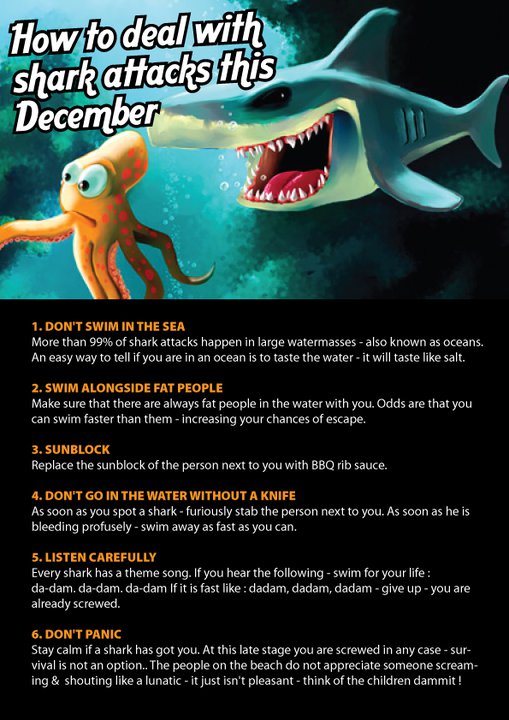 At the same time, try not to dive under the water! You should glide through the water as smoothly as possible and without vertical movements.
At the same time, try not to dive under the water! You should glide through the water as smoothly as possible and without vertical movements.
For your own test, you can put swimming goggles on the back of your head, and make an arrow with them. If the glasses did not fall off and the water did not wash them off, then you did the exercise perfectly!
In the future, before each workout, I advise you to devote 5-7 minutes to these two basic swimming exercises - the arrow and the jellyfish. They will greatly help you swim freestyle or breaststroke with maximum energy savings.
And very soon we will teach you other exercises that will help you swim for a long time without panting and without getting tired quickly.
And for now, I say goodbye, have a great swim, subscribe to the channel and my instagram, put likes if the video seemed useful and see you, bye!!
Swim school Helpful Hints How not to get tired when swimming?
Useful tips • Miscellaneous and interesting about swimming • Coach's advice
Nikita Kislov, founder of the swimming school SwimRocket
For example, when we swim with our heads up, we spend a lot of strength and energy (This is not right!).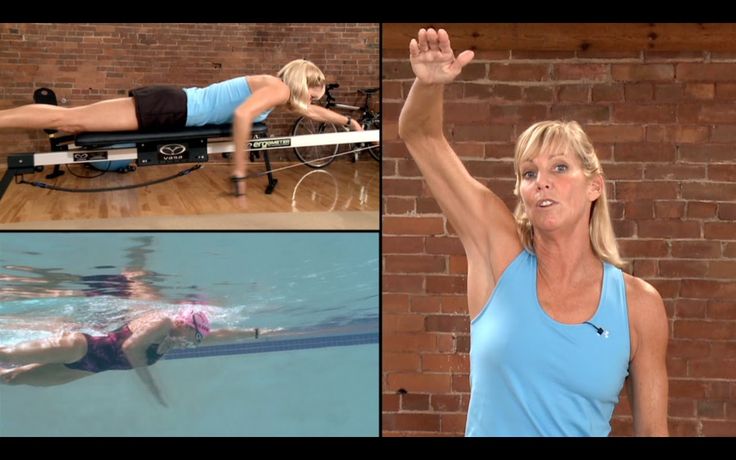 It also takes a lot of strength to shake the head from side to side. This is what most beginner swimmers do. We just need to lower our head and relax, so it will be much easier for us. Another reason: During freestyle, we pull our hand out too early. Because of what our fungus becomes short. Tip: Row as far as possible, so we will swim much more efficiently and not get tired.
It also takes a lot of strength to shake the head from side to side. This is what most beginner swimmers do. We just need to lower our head and relax, so it will be much easier for us. Another reason: During freestyle, we pull our hand out too early. Because of what our fungus becomes short. Tip: Row as far as possible, so we will swim much more efficiently and not get tired.
The second important factor that affects fatigue is stroke rate. Most amateurs believe that the more often they work with their hands, the better. Actually it is not. Stroke frequency affects speed in professional athletes. The quality of their stroke does not change. For amateurs, a high stroke rate raises the pulse, knocks down breathing and increases fatigue. Tip: Try to swim lightly and pull your arms as far as possible. In our case, we will spend the same amount of time, but get tired much less.
Someone is trying to exhale all the air from the lungs to the end, someone is breathing at the wrong moment. Two rules for a swimmer:
Two rules for a swimmer:
Advice: We must exhale in advance under the water. So that when we turn our heads we are ready to take a breath.
Most people think that we float on the surface of the water with our hands. This is not true! Through the hands in swimming we move forward. And we must stay on the water due to balance and body. Because of this, many people try to work with their hands and get tired and clogged, as a result of which we get short of breath and we get tired. Tip: Try to swim lightly, relaxed, enjoy swimming and not lean on your hands. Try to keep your body in balance. You can see visually each of the swimming techniques, as well as many other useful videos on our channel YouTube Also, if you want to learn how to swim and not make mistakes, then sign up for training at SwimRocket swimming school